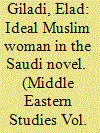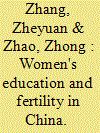| Srl | Item |
| 1 |
ID:
192278


|
|
|
|
|
| Summary/Abstract |
The gender ideology promoted within Saudi political culture constructs a model of the ‘ideal Muslim woman’. This ideal woman is a wife and a mother whose place is in the private sphere, and men are her guardians. Women who remain in their homes, raising the next generation and preserving the traditional values, constitute the quintessential emblem of the unique Saudi national identity. Based on a critical analysis of some 30 Saudi novels written between 1980 and 2000, this study focuses on the changes in the model of the ideal Muslim woman, alongside changes in Saudi attitudes toward women's education and employment. I argue that whereas the regime cultivated the traditional perception of the ideal woman and conservative attitudes toward women's education and employment, the novels presented and constructed hybrid perceptions of these issues, and gradually developed a sharply critical perspective on them.
|
|
|
|
|
|
|
|
|
|
|
|
|
|
|
|
| 2 |
ID:
192392


|
|
|
|
|
| Summary/Abstract |
Using data from the China Family Panel Studies, this paper exploits the Compulsory Education Law of China implemented in the 1980s to empirically examine the causal impact of women's education on fertility in rural China by difference-in-differences methods. The results show that an additional year of schooling lowered the number of children a woman would have by approximately 0.09 children, postponed the age of first childbirth by 0.7 years, and reduced the probability of having a second child or more children by 0.18 among those mothers whose first child was a girl. In addition to the income effect, these results are also partly explained by more educated women preferring quality to quantity of children, placing a greater value on leisure and no longer perceiving children as the sole focus in their lives.
|
|
|
|
|
|
|
|
|
|
|
|
|
|
|
|